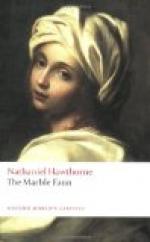An imaginative man, he suffered the penalty of his endowment in the hundred-fold variety of gloomily tinted scenes that it presented to him, in which Hilda was always a central figure. The sculptor forgot his marble. Rome ceased to be anything, for him, but a labyrinth of dismal streets, in one or another of which the lost girl had disappeared. He was haunted with the idea that some circumstance, most important to be known, and perhaps easily discoverable, had hitherto been overlooked, and that, if he could lay hold of this one clew, it would guide him directly in the track of Hilda’s footsteps. With this purpose in view, he went, every morning, to the Via Portoghese, and made it the starting-point of fresh investigations. After nightfall, too, he invariably returned thither, with a faint hope fluttering at his heart that the lamp might again be shining on the summit of the tower, and would dispel this ugly mystery out of the circle consecrated by its rays. There being no point of which he could take firm hold, his mind was filled with unsubstantial hopes and fears. Once Kenyon had seemed to cut his life in marble; now he vaguely clutched at it, and found it vapor.
In his unstrung and despondent mood, one trifling circumstance affected him with an idle pang. The doves had at first been faithful to their lost mistress. They failed not to sit in a row upon her window-sill, or to alight on the shrine, or the church-angels, and on the roofs and portals of the neighboring houses, in evident expectation of her reappearance. After the second week, however, they began to take flight, and dropping off by pairs, betook themselves to other dove-cotes. Only a single dove remained, and brooded drearily beneath the shrine. The flock that had departed were like the many hopes that had vanished from Kenyon’s heart; the one that still lingered, and looked so wretched,—was it a Hope, or already a Despair?
In the street, one day, the sculptor met a priest of mild and venerable aspect; and as his mind dwelt continually upon Hilda, and was especially active in bringing up all incidents that had ever been connected with her, it immediately struck him that this was the very father with whom he had seen her at the confessional. Such trust did Hilda inspire in him, that Kenyon had never asked what was the subject of the communication between herself and this old priest. He had no reason for imagining that it could have any relation with her disappearance, so long subsequently; but, being thus brought face to face with a personage, mysteriously associated, as he now remembered, with her whom he had lost, an impulse ran before his thoughts and led the sculptor to address him.
It might be that the reverend kindliness of the old man’s expression took Kenyon’s heart by surprise; at all events, he spoke as if there were a recognized acquaintanceship, and an object of mutual interest between them.
“She has gone from me, father,” said he.




